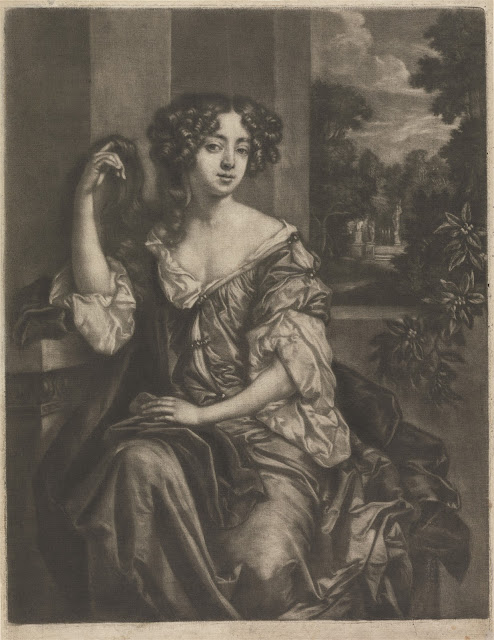There are so many women from history whose stories have been made into films. There's Marie Antoinette, captured in candy-coloured stripes and bows and played by Kirsten Dunst in 2006. And then of course Anne Boleyn, played by actresses including Merle Oberon, Genevieve Bujold, Natalie Dormer and, more recently, Jodie Turner-Smith. Elizabeth I has been portrayed on the silver screen by Judy Dench, Cate Blanchett and Margot Robbie. In these films, there's usually a focus on the woman's adversities, her ability to rise above them and then some hint of tragedy. And so, as I was researching the life of Louise Kerouaille in the late seventeenth century, I wondered why a movie hadn't been made about her.
 |
| Print made by Paul van Somer, ca. 1649–ca. 1694, Dutch, Louise, Duchess of Portsmouth, ca. 1680, Mezzotint, Yale Center for British Art, Paul Mellon Collection, B1974.12.622. Public Domain. |
Kerouaille was born to high-born parents. Named Louise Renée de Penancoet Keroualle, her father was Guillame de Penancoet and her mother Marie, daughter of Sebastien du Ploeue. Born in around 1647, she lived in Brittany until she was brought to England in around 1670 by none other than the king's sister, Henrietta Marie, the Duchess of Orleans. Louise, then aged around twenty-three, stepped off the ship's wooden gangplank into a land recently rattled by plague, fire and foreign tensions. She would have noticed the rebuilding of London's skyline, altered forever by the Great Fire that had raged just four years before. Beautiful and noted for her good manners, the diarist Evelyn had written that she had a childish, simple and 'baby face'. She was almost immediately instated as a Maid of Honour to Charles' queen, Catherine of Braganza in the November of the year of her arrival, 1670.
Unsurprisingly, it was not long before Louise became Charles' mistress, one of the many that sought the undivided attention of the king. His marriage to Catherine was not a successful one and they produced no children together, although the king did sire a number of children out of wedlock. In July 1672 Louise gave birth to Charles, named after his royal father, the king creating the boy Duke of Richmond. Typically, Charles rewarded his mistresses with wealth and titles and on 19 August 1673 he granted some to Louise linked to Hampshire. She became Baroness Petersfield, Countess of Fareham and Duchess of Portsmouth. On the same date she was raised to Lady of the Bedchamber at court.
In just three years Louise had been fully integrated into the royal court. She had a royal son, acknowledged by his father and awarded with a dukedom. She may have been present when her son, aged nine, was instated as a Knight of the Garter in a prestigious ceremony headed by his father in 1681. The title had been borne by another illegitimate son of a king, Henry Fitzroy (the son of Henry VIII and his mistress Elizabeth Blount) in 1525. With her many titles, Louise presided over the exciting and glamorous centre of Charles' court and had a pivotal role in the queen's household, enjoying her own income. She would have come into contact with women such as Nell Gwynne, another mistress of the king's, as well as Barbara Villiers and other women at the court. She was also painted by the prolific artist Peter Lely, contemporary portraits showing her gazing coyly out of the canvas, her glossy dark curls falling around her neck. More titles would soon come. In December 1673, Charles granted her the Seignory of Aubigny, and in 1684 the French king raised her to Duchess. However, as with so many royal mistresses in history, everything changed for Louise on Charles' death, on 6 February 1685.
On the death of the king, Cokayne writes that Louise went to live in Aubigny in France. She is noted as a 'poor pensioner' in 1718, residing at the French court, seen gambling and spending her way through her funds. She may have had a natural tendency to spend, and this may have been the reason Charles, and later Louis XV, granted her these titles and sources of income. Her son was also known to have been a lover of excess, Cokayne noting he was 'addicted to drunkenness and other vices'. Richmond however managed to maintain an active role in England at court, bearing the sceptre and dove at the coronation of Queen Anne in 1702 and created Lord of the Bedchamber in 1714. He died in 1723. Having outlived her son, Louise, soon after, passed away in Paris on 14 November 1734, aged around eighty-seven years old.
Her story is, in part, a tragedy. She was famed for her beauty, painted by famous Restoration artists and embarked on a love affair with Charles II. But her story ends with the death of her son and lover, her contemporaries noting her out of control spending and poverty at the end of her life.
Liked this? You might also like these posts with London's Historic Coffee Houses from the Seventeenth and Eighteenth Centuries, Lady Mary Bankes and the Seige of Corfe Castle and The Murderesses of Stuart London.
If you're interested in Women's History you might also enjoy my book, Forgotten Women of the Wars of the Roses, exploring ladies in waiting, servants, mistresses and others who influenced (or were influenced by) the fifteenth century conflict. Order your copy here.
Notes
Cokayne, The Complete Peerage, volume 6, edition 1, p278-280 and p361-364


















0 Comments